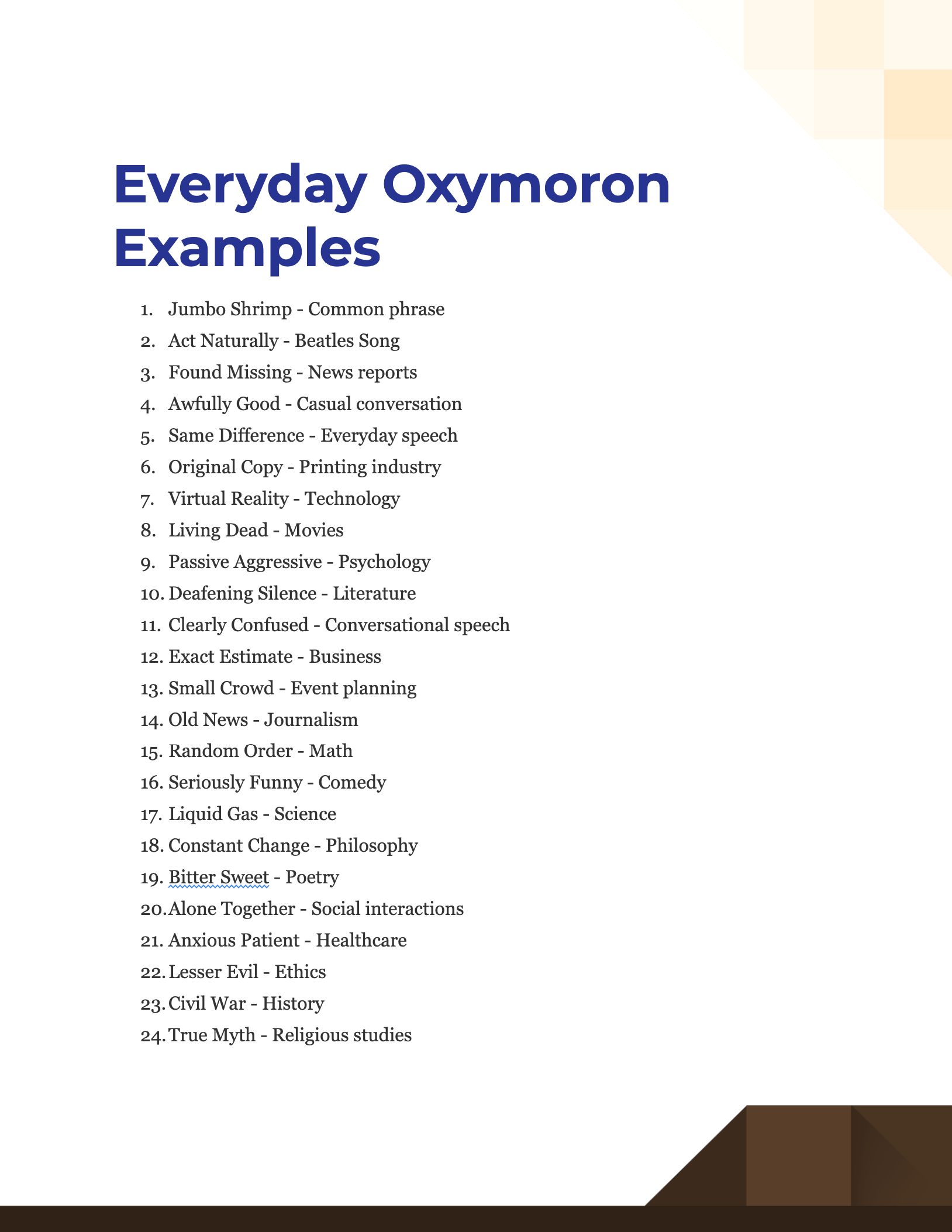99+ Everyday Oxymoron Examples
Delve into the intriguing world of Everyday Oxymorons—those contradictory terms that pepper our daily conversations. Discover the art and impact of using these expressive phrases. Whether you’re a language enthusiast or just curious, our guide offers valuable tips on writing and recognizing Everyday Oxymorons to enhance your communication skills.
What is an Everyday Oxymoron? – Definition
An Everyday Oxymoron is a figure of speech containing contradictory elements that appear in our regular conversations. These phrases may seem illogical at first, but they often encapsulate complex ideas or emotions succinctly.
What is the best Example of an Everyday Oxymoron?
One quintessential example of an Everyday Oxymoron is “jumbo shrimp.” At first glance, the term is paradoxical because “jumbo” implies something large, while “shrimp” often refers to something small. However, this oxymoron efficiently conveys the idea of a shrimp that is large compared to others of its kind.
100 Everyday Oxymoron Examples

Discover a fascinating compilation of 100 Everyday Oxymorons that you probably encounter more often than you realize. These captivating examples shine a light on the way we use language in our day-to-day lives. This curated list of oxymorons is designed to elevate your understanding and appreciation of linguistic quirks that make English such an intricate language.
- Jumbo Shrimp – Common phrase
- Act Naturally – Beatles Song
- Found Missing – News reports
- Awfully Good – Casual conversation
- Same Difference – Everyday speech
- Original Copy – Printing industry
- Virtual Reality – Technology
- Living Dead – Movies
- Passive Aggressive – Psychology
- Deafening Silence – Literature
- Clearly Confused – Conversational speech
- Exact Estimate – Business
- Small Crowd – Event planning
- Old News – Journalism
- Random Order – Math
- Seriously Funny – Comedy
- Liquid Gas – Science
- Constant Change – Philosophy
- Bitter Sweet – Poetry
- Alone Together – Social interactions
- Anxious Patient – Healthcare
- Lesser Evil – Ethics
- Civil War – History
- True Myth – Religious studies
- Crash Landing – Aviation
- Fresh Frozen – Food industry
- Growing Smaller – Economy
- Passive Resistance – Sociology
- Rolling Stop – Traffic rules
- Silent Scream – Horror genre
- Living Hell – Personal experience
- Temporary Fix – DIY
- Advanced Basic – Programming languages
- Known Secret – Spy genre
- Passive Income – Finance
- Controlled Chaos – Management
- Poorly Educated – Social studies
- Holy War – Religious conflicts
- Resident Alien – Immigration
- Near Miss – Aviation
- Silent Alarm – Security systems
- Tragic Comedy – Theatre
- Freezer Burn – Cooking
- Student Teacher – Education
- Negative Growth – Economics
- Painfully Beautiful – Aesthetic appreciation
- Dark Light – Mysticism
- Same Opposite – Philosophy
- Even Odds – Gambling
- True Lies – Movies
- Open Secret – Popular culture
- Original Remix – Music
- Quiet Riot – Rock band
- Fixed Rate Variable – Finance
- Harmless Crime – Legal studies
- Clearly Invisible – Spy tech
- Free Gift – Marketing
- Living Fossil – Paleontology
- Blind Eye – Metaphor
- Numb Feeling – Healthcare
- Plastic Silverware – Table setting
- Small Fortune – Wealth
- Minor Crisis – Management
- Optional Requirement – Education
- Criminal Justice – Legal system
- Passive Activity – Leisure time
- Idiot Savant – Psychology
- Guest Host – Entertainment industry
- Wicked Good – New England slang
- Peace Force – Military
- Random Logic – Game theory
- Loud Silence – Sound studies
- Practical Magic – Fantasy
- Anarchy Rules – Politics
- Chaotic Order – Complexity theory
- Civil Disobedience – Social movement
- Close Distance – Navigation
- Complex Simplicity – Design
- Cursed Blessing – Folk tales
- Epic Fail – Internet slang
- Foolish Wisdom – Philosophy
- Free Market – Economics
- Future Past – Time travel narratives
- Genuine Fake – Art
- Happy Tears – Emotion
- Human Robot – Science fiction
- Icy Hot – Sports medicine
- Inside Out – Psychology
- Irregular Pattern – Fashion
- Junk Food – Nutrition
- Lethal Aid – Military aid
- Limited Edition – Marketing
- Lonely Crowd – Sociology
- Minor Major – Music theory
- Natural Synthetic – Chemistry
- Nonprofit Business – Social enterprise
- Open Secret – Political discourse
- Passive Energy – Sustainability
- Quiet Noise – Acoustic studies
- Serious Joke – Comedy shows
What is an Oxymoron in Everyday Life?
An oxymoron in everyday life refers to a combination of contradictory or incongruent words used casually in speech or writing. These terms are deeply ingrained in daily conversation, literature, and even in product naming. The interesting part about these oxymorons is that despite the apparent contradiction in terms, they serve to make a point or draw attention more vividly than using plain language. For instance, when someone says “deafening silence,” the oxymoron effectively highlights the profound impact of the silence.
What is the Most Famous Oxymoron?
The title of “most famous oxymoron” might vary depending on cultural context and individual perspective, but one contender is “Jumbo Shrimp.” This oxymoron is widely recognized because it appears frequently in daily life, particularly in the context of dining or grocery shopping. The term intriguingly combines “jumbo,” meaning large, with “shrimp,” a creature that is often considered small. Despite its contradictory nature, “Jumbo Shrimp” effectively communicates the idea of a shrimp that is larger than average, making it an enduring example of how oxymorons can serve a practical purpose.
What is an Easy Oxymoron?
An easy oxymoron is one that is simple to understand, even for people who might not be familiar with the concept of oxymorons. Examples of easy oxymorons include phrases like “act naturally” or “same difference.” These oxymorons are considered easy because they are commonly used in everyday language and require little to no explanation for most people. They frequently appear in casual conversation and are readily understood due to their widespread usage and inherent relatability. Therefore, an easy oxymoron is not only straightforward but also instantly recognizable, serving its intended purpose efficiently.
How do you write an Everyday Oxymoron? – Step by Step Guide
Writing an everyday oxymoron involves a process of creative thought and linguistic skill. These oxymorons are often the result of poetic license or clever wordplay. Here is a step-by-step guide on how to craft your own everyday oxymoron:
- Identify the Context: Determine the situation or the setting where you want to use an oxymoron. This context can guide the choice of words and make the oxymoron more relevant.
- Brainstorm Keywords: List down the words or ideas you want to express. Think of adjectives and nouns that are directly in opposition to each other but could make sense when put together.
- Combine Creatively: Start combining your chosen words. Remember, the goal is to create a term that at first glance appears contradictory but makes sense when pondered upon.
- Test for Effectiveness: Use your newly created oxymoron in a sentence to see if it conveys the message you intended. Does it add depth or emphasis to what you’re trying to communicate?
- Get Second Opinions: Sometimes, it helps to get a fresh perspective. Share your oxymoron with friends or colleagues to gauge its impact.
- Revise: Based on the feedback and your own assessment, tweak the oxymoron for better impact or clarity.
- Use It: Once satisfied, start using your oxymoron in the intended context. Take note of the reactions it elicits and be prepared to explain its meaning if asked.
Tips for Using Everyday Oxymoron
- Understand the Purpose: Know why you’re using an oxymoron. Is it for emphasis, humor, or to make someone ponder on a concept? The purpose will guide effective usage.
- Context is Key: Oxymorons are most impactful when they fit the conversation or writing style. An oxymoron out of context can confuse rather than enlighten.
- Keep It Simple: The best oxymorons are easy to understand. Overcomplicating things may dilute the impact.
- Be Mindful of the Audience: Your oxymoron should be appropriate for your target audience. What works in a casual setting may not be suitable for a formal event.
- Avoid Redundancy: Using too many oxymorons in quick succession can lessen their impact. Use them sparingly for maximum effect.
- Explain When Necessary: Not everyone may understand the oxymoron you’ve used. Be prepared to provide a brief explanation if the situation calls for it.
- Incorporate in Various Forms: Oxymorons can be used in speech, writing, or even visual media. Understanding the medium can help you use the oxymoron most effectively.
- Review and Revise: Like any other form of communication, the effectiveness of an oxymoron can wane over time or across different settings. Be prepared to update or change your oxymorons as necessary.
By following these guidelines, you can create and use everyday oxymorons that enrich your language and make your communication more engaging and effective.



